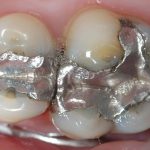New research exposes hidden dangers of “silver” fillings
 (NaturalHealth365) For generations, dentists have been placing what they call “silver fillings” in our mouths. What they often fail to mention is that these fillings are actually 50% mercury, one of the most toxic substances known to science.
(NaturalHealth365) For generations, dentists have been placing what they call “silver fillings” in our mouths. What they often fail to mention is that these fillings are actually 50% mercury, one of the most toxic substances known to science.
And while conventional dental associations continue to defend this practice, shocking new research suggests these common dental fixtures are slowly poisoning millions of Americans.
“Silver” fillings put unborn babies at risk
A new study from the International Academy of Oral Medicine and Toxicology (IAOMT) revealed a disturbing truth: nearly a third of pregnant women with amalgam fillings are being exposed to mercury vapor at levels exceeding EPA safety limits. This research, examining data from 1.67 million expectant mothers, found that mercury from dental work doesn’t just stay in your mouth – it circulates throughout your body and can cross the placental barrier.
“These findings underscore the need for heightened awareness of the risks to dental patients and policy shifts regarding the use of dental amalgams,” warned Dr. Charles Cuprill, past president of the IAOMT.
The arthritis link no one’s talking about
For years, patients complaining of joint pain after dental work were dismissed. Now we know better. Researchers examining national health survey data discovered that arthritis diagnoses peaked in adults with even modest numbers of amalgam surfaces.
Most shocking was that the connection appeared with as few as 4-7 amalgam surfaces, not entire fillings, but surfaces. Since a single filling can cover multiple surfaces of a tooth, this means even one or two larger amalgam fillings could potentially trigger inflammatory disease.
The implications are staggering when you consider that roughly 91 million American adults still have at least one amalgam filling in their mouths.
Mercury’s silent invasion
The frightening truth is that you’re unwittingly releasing toxic mercury vapor every time you bite into an apple, sip your morning coffee, or clench your teeth during a stressful meeting. This vapor doesn’t just hang around your mouth – it goes straight into your bloodstream and begins its journey through your body.
Mercury is notorious for accumulating in vital organs. Your brain is particularly vulnerable, along with your kidneys and liver. We’re not talking about some vague theoretical risk either – the evidence was compelling enough that the FDA finally had to act in 2020, warning that pregnant women, children, and people with certain health conditions should avoid these fillings altogether.
But many critics believe this warning came decades too late and doesn’t go far enough. Dr. Tom Lonsdale, who’s spent 30 years researching dental toxicity, puts it bluntly: “Mercury disrupts fundamental cellular processes – it’s like your body is trying to function with a persistent low-grade poisoning.”
The slow poison effect
What makes mercury from dental fillings particularly dangerous is that it’s not a one-time exposure. These fillings slowly leak mercury day after day, year after year. Your morning tooth-brushing routine? That releases mercury. Chewing gum? More mercury. Over time, your body’s natural detoxification systems simply can’t keep up.
This constant exposure can trigger widespread inflammation, disrupt hormone balance, and compromise immune function. Many patients report mysterious symptoms that doctors struggle to diagnose – fatigue, brain fog, autoimmune conditions, and more.
And if you think removing old fillings solves the problem, be careful. Having amalgams drilled out by a regular dentist can cause dangerous mercury spikes as the filling is broken up. One study found mercury vapor levels can increase up to 30 times during improper removal.
Taking action: What you need to know
If you have mercury fillings, removing them safely is crucial, but it must be done properly. Standard dental procedures for amalgam removal can release dangerous levels of mercury vapor directly into your bloodstream and lungs.
The Safe Mercury Amalgam Removal Technique (SMART) was developed specifically to address these risks. Dentists certified in this protocol use specialized equipment, including high-powered suction placed directly beside the filling, barriers to prevent swallowing particles, and often separate air supplies to protect patients from inhaling toxic vapor. These precautions might seem excessive, but considering what’s at stake, they’re absolutely necessary.
Before removal, prepare your body to handle the inevitable mercury exposure. Most biological dentists recommend starting supportive supplements at least two weeks before your procedure. Substances that support liver function and bind to heavy metals can make a significant difference in how well your body processes the released toxins. Even simple measures like increasing water intake, consuming more detoxifying foods, and ensuring adequate sleep can substantially support your body’s natural elimination processes.
After removal, be careful about what goes back into your mouth. Don’t simply accept whatever material your insurance covers. Some composite materials contain BPA and other compounds that can cause their own health issues. Ask specifically about biocompatible options that won’t create new problems while solving the old ones.
For many patients, particularly those who’ve had amalgam fillings for decades, a structured detoxification program supervised by a healthcare provider experienced in environmental medicine might make sense. These protocols typically combine targeted nutritional support with specific agents that help mobilize and eliminate stored mercury from tissues where it has accumulated over years of exposure.
The good news is that dentistry is finally moving away from these toxic materials. Recent statistics show that less than 6% of fillings placed in 2022 contained mercury – a dramatic drop from just five years earlier. But for the tens of millions of Americans still carrying these fillings, the toxic exposure continues daily.
The evidence against mercury amalgam has become too compelling to ignore. What the dental industry once declared perfectly safe is now increasingly recognized as a significant health risk.
Comprehensive information is vital for anyone concerned about mercury exposure from dental work. Jonathan Landsman’s Holistic Oral Health Summit brings together leading researchers and clinicians in biological dentistry to share practical, science-based approaches to addressing dental toxicity and restoring optimal health.
Sources for this article include:



